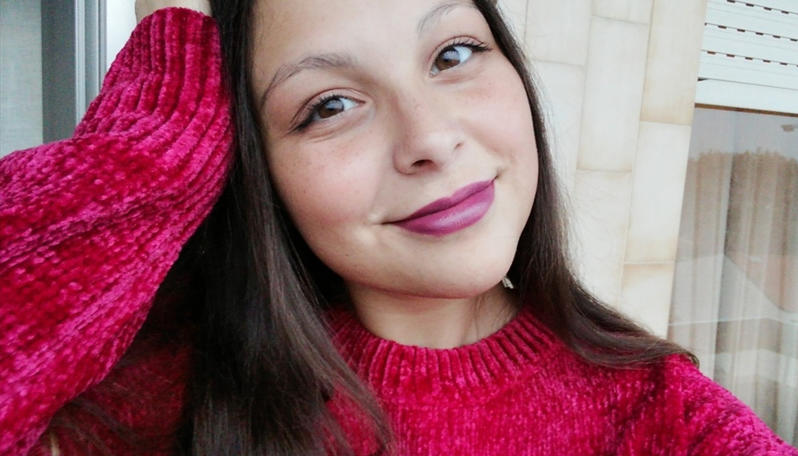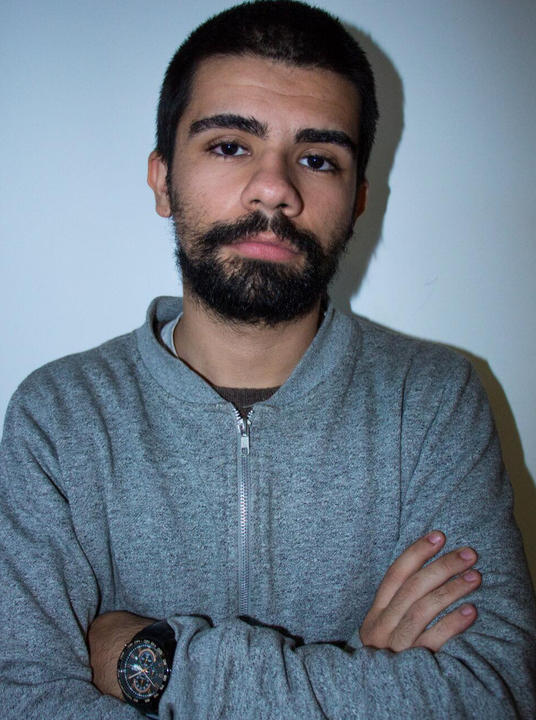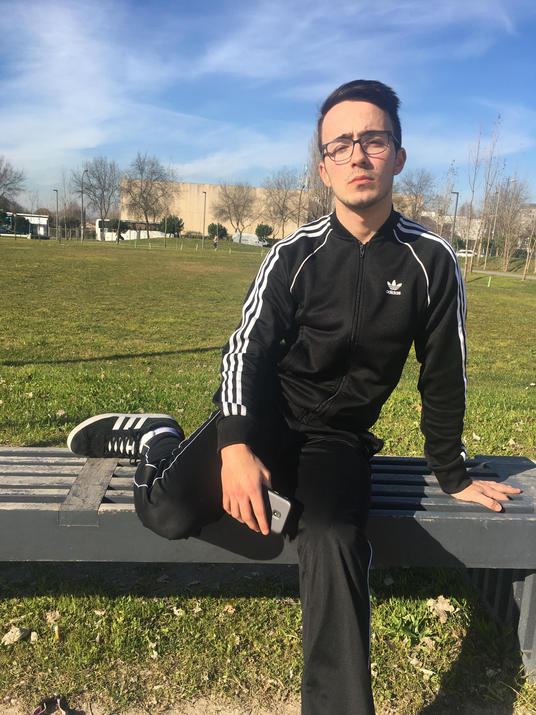How are LGBT+ people portrayed on traditional TV?
In this project we are going to talk about how LGBT+ people have been represented through times on traditional TV and how this representation evolved.
Biosketches
Hello! My name is Ana Margarida, I am 18 years old and I live in Oporto, which is located in Portugal.
In the last three years I have studied sciences and that was the moment I realized my real passion were languages. Currently, I am studying foreign languages and cultures at ESE and I could not be happier.
I also played cello for 6 years and I absolutely love to sing, to draw, to listen to music, to cook and especially to be with my friends and family who have always supported me.
A meaningful achievement for me is to conclude the degree successfully and to make my parents proud of whom I will become.

Hello, my name is Clara Marinho, I'm 18 years old and I'm from Porto.
I'm studying foreign languages and cultures at ESE and i'm really enjoying it because I'm extremely interested inlearning new languages.
One of my favourite hobbies is to watch movies and TV shows and I tend to binge watch them a lot.
I also love listening to music and enjoy spending time with my friends every chance that I get.I've travelled to other countries with them and It's something really rewarding and I would like to share more experiences like that with them.

Hi! My name is João Vilaça and I am a 20 years old student. I am from Famalicão, Braga and I study in Escola Superior de Educação in the degree of Languages and Foreign Cultures.
I am currently in the first year of my degree and I have to say I am enjoying it too much. I have a big love in learning languages and the degree helps me with it. My main goal with this degree is to become a translator or a languages teacher.
Matrizes is a very interesting subject because it helps us understanding better media and its world goes around and functions. I hope by the end of this semester I become a more literate student and a better media user.

My name is Rúben Silva, I am 19 years old and I live in Porto. I study Foreign Languages and Cultures at Escola Superior de Educação do Porto.
During the professional course I did within high school, I studied tourism and so I did trainings in two different hotels. Last year, I had the chance of having my actual first job in a hotel: I took the chance and I had very pleasant 6 months working there.
I have already played kickboxing, swimming and handball. Then, I became a dancer and I currently play karate. Music is what I love the most, specifically music in English. And finally, I am the official representor of the first year of my degree.
I think Matrizes Culturais Inglesas nos Media are really interesting because it teaches us to see the world around media from a very different and concrete perspective. We are used to see things in media as they are, but here we are able to understand the reasons why they are like that.

Did LGBT+ people exist in the past?
From ancient times until now, LGBT+ people have always existed. However, nowadays they do not hide themselves anymore in comparison to a couple decades ago and they express their sexual preferences more freely.
Somewhere in between 96th century BCE and 50th century BCE, phallic mate figures have been found in pairs in the Mesolithic Rock Art in Italian territory, more specifically in Sicily. Further, on 29th/25th century more a less, in Czech Republic, more specifically Prague, what archaeologists think it was a transgender male was buried in the outfit of a woman. Apparently the first same-sex couple in history was Khnumhotep and Niankhkhnum and at the 7th century BCE the custom of castrating homosexual slave and house servants was introduced in Persia.
Some centuries after, it emerged a cup with images of same-sex male acts. At 54 AC, Nero, the Emperor of Rome, legally married two men. Later on, also in Rome, it was introduced capital punishment for homosexual rape and other important male figures of Roman Empire likewise married other men. After all these centuries, we can also see a clear evolution that took place in society. For example, in 4th October 2018 LGBT appeared for the first time in a Vatican document and even though there is some controversy in this matter, this is an obvious improvement.
To conclude, we can easily verify that although it was uncovered, LGBT+ people have always existed within our community and that at the end of so many centuries they no longer need to hide themselves.
How did LGBT+ people representation evolved?
Initially the term “homosexual” was replaced by “homophile” in the 50s and 60s and subsequently “gay” in the 70s and it is still the term with a wider usage around the world.
The first lesbian civil and political rights organization was called “The Daughters of Bilitis” and it was formed in San Francisco in 1955. As homosexual people, bisexual and transgenders were also recognized as legitimate categories within the larger minority community.
Through times, other terms began to join those that already existed and all these concepts started to have more acceptance between larger communities.
Nowadays, we even have a national charity delivering advice, support and information services to LGBT+ communities. This community also has more visibility because of their symbols. An example of that is the rainbow flag used in pride parades among others, which has six different colours with six different meanings: red for life, orange for healing, yellow to represent the sun, green for nature, blue for art and violet to symbolize the spirit. Besides this flag, we also have the Greek Lambda Symbol (λ) that means liberation, the ribbons or the triangles, that became a mark for the Jewish homosexuals after the Holocaust. Our society has also evolved in a way that same-sex marriage is now legally allowed and since this is a sensitive topic, we can clearly say that LGBT+ people are more accepted than they were some decades ago.
In conclusion, although these people are not acknowledged by everyone, I think it is important to refer that their representation and their rights have been recognized and that is a huge step if we go back a few centuries ago.
By: Margarida
Sources used:
https://prezi.com/m/oiz6kqb4p3uw/switzerland/
https://www.google.com/amp/s/asviagensdare.com/2016/11/29/zibelemarit-festa-da-cebola/amp/
https://www.eda.admin.ch/aboutswitzerland/pt/home/gesellschaft/traditionen/feste-und-braeuche-im-herbst.html
http://m.interlaken.ch/en/chaesteilet-justistal
http://www.casasuica.info/pages/calendario/manifestacoesdetalhes.php?codigomanifestacao=1
http://glaad.org/files/WWAT/WWATGLAAD2017-2018.pdf
https://en.wikipedia.org/wiki/MediaportrayalofLGBTpeople
How is this LGBT+ representation on tv viewed by the audiences?
Now that you can see lgbt+ characters a little everywhere on tv people can have mixed opinions about it, especially if we compare the non-heterosexuals to the heterosexuals.
Firstly from the LGBT+ people’s side they believe this representation still isn’t enough and that they represent in the majority gay and lesbian people but forget the other spectrums of the group. On the other side they value the appearance of these few characters and say that having these figures growing up made them feel like they weren’t alone and were validated.
If we now look at the viewers who are heterosexual the response can be very wide. In a negative connotation people with catholic views generally thin that there shouldn’t be any representation of this group of people on tv because they feel that it’s a sin. Another side of the situation are the mothers who think that kids shouldn’t watch these shows with queer characters because it can “influence their kids to become gay”. Although these are very negative ways to look at the situation these two instances don’t equal most of the opinion.
Teenagers especially, who are more open minded than anybody, love seeing this representation on tv even if they themselves are not part of the lgbt+ group. They sometimes go watch a show just because of their lgbt+ characters not only because they want to show their support for this group of people but also because they personally feel happy that these people are finally getting validated.
To conclude, episodes where gay characters appear dating or getting married get larger views than the rest and shows that have gay characters get a larger audience just because they have these gay characters. So generally this shows that the bigger part of the audience is interested in this and sees it in a positive way.
How were LGBT+ people represented in the past?
Nowadays the non-heterosexual are being represented on traditional tv very differently comparing to the past. In general, this interpretation has become more positive along the way.
In general since the creation of TV there had rarely been appearances of a LGBT+ character on shows and if they were mentioned they were described negatively as child molesters or victims of violence. These awfully wrong stereotypes continued until the 1970’s. From that point on because of riots created by the community to ask for a better representation on tv shows began showing gays on a positive light. But aside all that the gay characters weren’t generally very present and if they were, they were never the main character and would generally appear for a couple of episodes where homosexuality was the problem and then they would never be relevant again.
Later in the 1980 with the appearance of AIDS and blaming it on gay people the media coverage varied and even though these people gained more importance it was a very negative one also because religion started to get involved.
But in 1997 Ellen became the first show with a gay main character and even though the show lost a lot of its sponsors the episode was very well received and the show was renewed for a new season, this was one big step for LGBT+ representation on TV.
Although the gay and lesbian were given some screen time other sexualities or other parts of these community were not even shown validation on screen. The transgenders, the asexuals, the non-binary people and others were never given much attention before and even now.
So in the past the LGBT+ people were viewed very negatively. But step by step this started to improve and even thought this representation was full of stereotypes and full of lies it was shown in a more positive way.
By: Clara
Sources used:
https://www.pinknews.co.uk/2017/04/19/overwhelming-majority-think-there-arent-enough-lgbt-characters-on-tv-or-in-films/
https://www.theguardian.com/tv-and-radio/2018/oct/25/lgbt-characters-at-record-high-on-tv-report-finds
https://scholar.utc.edu/cgi/viewcontent.cgi?article=1133&context=honors-theses
https://www.ncbi.nlm.nih.gov/pmc/articles/PMC2000838/#R8
What is traditional TV?
We can state that traditional TV is something we do when we lay back and enjoy whatever is on at TV. But, is this the real definition of traditional TV? Or is this even a definition of something?
By definition, television is “an electronic system of transmitting transient images of fixed or moving objects together with sound over a wire or through space by apparatus that converts light and sound into electrical waves and reconverts them into visible light rays and audible sound”. And traditional television are the images (fixed or moved) that are brought to us through tradition. What tradition? The one that is brought to us by our ancestors and the tradition we are transmitting to our kids. This tradition is being shaped though, because we tend to use new ways to get images to us, and this is more and more becoming traditional TV.
So, as far as we can tell, laptops and notebooks are not considered part of traditional TV, yet. We live in a world where, supposedly, traditional TV is losing a race against new forms to get to us what we need to see. This is getting more and more attention, because we don’t need to follow a schedule or record something.
Imagine yourself reading a book, but you can only read that book once a week, at a determined time. That is what traditional TV has been doing to us since the beginning. We wait, a whole week, just to see the following episodes of, for example, some series we are watching. We wait until eight o’clock (in Portugal) to see the news of the day, every day of the week. This is why people are saying traditional TV is dying. New ways of watching what we want are easier and to be honest, more convenient to us.
How is traditional TV seen nowadays?
Traditional TV can be a very subjective matter. Nowadays we live in a world that traditional TV is considered to be what we see in our screens, and the way we absorb the information that is given to us. But, are televisions still the dominant force within our homes?
As days pass, we discover new ways to explore the world; we also discover new ways to transmit it. Streaming is getting more and more attention and being into this stereotype called “traditional TV”. Netflix and Twitch are the ones that get the biggest attention at the moment.
Quoting Netflix official website, Netflix defines itself as “a streaming service that allows customers to watch a wide variety of award-winning TV shows, movies, documentaries, and more on thousands of internet-connected devices.” It is a simple method, you create a paying account and you get a wide variety of shows, movies and other kind of TV considered things. This is getting more and more costumers, because it is a legal way to watch everything that was broadcasted on TV.
Twitch on the other hand, is more an option to those who pay more attention to gaming. In a more detailed definition, “Twitch is a popular online service for watching and streaming digital video broadcasts.(…) Twitch originally focused almost entirely on video games but has since expanded to include streams dedicated to artwork creation, music, talk shows, and the occasional TV series.”
Traditional TV is being shaped. And it’s always changing. And it will always be. TV is following people’s demands, and nowadays it’s easier to grab a computer and watch a stream. What’s next on the path of traditional TV?
By: João
Sources used:
https://help.netflix.com/en/node/412
https://martechtoday.com/traditional-tv-rolls-with-the-times-remains-a-viable-entertainment-channel-to-both-viewers-and-advertisers-217313
https://www.youtube.com/watch?v=fBafi8PsaHo
https://www.merriam-webster.com/dictionary/television
Who are LGBT+ people?
LGBT stands for lesbian, gay, bisexual and transgender. Along with heterosexual, they describe
people’s sexual orientation or gender identity. Further, we’ll explain these terms.
Lesbian
This is a person who is sexually, romantically or emotionally attracted to other women.
Gay
This is a general term that includes men and women, but most of the lesbian women prefer to
be called “lesbian” rather than “gay”, so we just apply it to men. So, a gay man is a man who is
romantically, sexually and/or emotionally attracted to another men.
It is good to say that either lesbian or gay people do not like to be referred to as “homosexual”
because of the negative historical associations with the word
Bissexual
It is the definition of a person who is romantically, sexually and/or emotionally attracted to
both genders.
Transgender
“Transgender” is a wide term used to describe people whose gender expression or identity
differs from the one associated with their birth sex. We tend to think that people are
transgender just because their appearance and/or behavior doesn’t match with their biological
physical gender. There are many people living part of their lives in another gender. Just for you
to know, transgender people can identify themselves as transsexual, transvestite or another
gender identity.
Gender Identity
It refers to whether one person feels male, female or transgender.
Transsexual people live or wish to live as members of the opposite gender rather than living
with the assigned one at birth. They can seek medical help, such as surgery and hormones, to
make their bodies fit as much as possible with their preferred gender. This process is called
gender reassignment.
Biological males who want to live and be recognized as women are called male-to-female
(MTF) transsexuals or trans women. On the other hand, biological females who wish to live
and be recognized as men are called female-to-men (FTM) transsexuals or trans men.
What are the stereotypes among LGBT+ people?
LGBT stereotypes conventional generalizations, images or opinions based on the gender identities or sexual orientations of LGBT people. Societies can acquire those stereotypical perceptions through interactions within school, family, friends and even mass media, or if we want to be more general, through a lack of contact and familiarity, resulting in an increased reliance on those generalizations.
Religion
On one hand, LGBT people are considered irreligious. On the other hand, the Human Rights Campaign proved that a person can be gay and religious. To help this affirmation, US News said “72% of adults describe faith as ‘very important’ in their lives, and so do 60% of LGBT people”.
Media
For decades, media have been moving forward to equally represent members of this community. This is important because there are not that many prominent LGBT characters in the mainstream media.
In recent years, it reached some milestones: 2016 – Drama film “Moonlight” became the first LGBT movie to win an Oscar; 2018 – “Love, Simon”, another groundbreaking movie wins an Oscar.
Although we have gone further than we could have ever imagined, LGBT members continue to be underrepresented and typecast.
Lesbians
To generalize, people assume they belong to one of the two following categories: butch (dressing in a more masculine manner) and femme.
Within the lesbian girls, there are many stereotyped ideas, like the following ones: they dress like men; they catch feelings easily; they have sort hair; they wear baggy clothes; they play sports; and many more to count.
Gay
Gay men are frequently seen as effeminate, theatrical and overly dramatic. Counting with many other generalized ideas, we can point the main ones: they are usually associated to the performing arts; gay men who are large and hairy are referred to as “bears”; and the same way round, thin and effeminate gay men are referred to as “twinks”; society is used to think that gay men carry more STI than heterosexuals; they are promiscuous and unfaithful; and many others…
By: Rúben
Sources used:
http://lgbt.ie/what-is-lgbt/
https://en.wikipedia.org/wiki/LGBT_stereotypes








